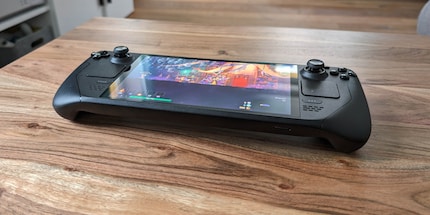
Product test
Better thanks to SteamOS: Lenovo Legion Go S review
by Philipp Rüegg

An OLED display, a more powerful battery and a new chip may not make the Steam Deck significantly faster, but it’s a better console in every other respect.
To shorten the wait for the Steam Deck 2, Valve launched the Steam Deck OLED back in November, replacing two of the three existing models. While the basic version with 256 GB of storage is the same as before, the 512 GB and 1 TB versions have now entered OLED territory. At first glance, the update seems unspectacular. However, if you ask me, it’s one of the most extraordinary mid-gen console upgrades ever. And I’m not just saying that because of the new display.
The Steam Deck OLED looks almost identical to its predecessor. Hardly any changes have been made to the design; the orange power button and black analogue stems instead of grey are the only indications of an upgrade. On top of these alterations, the display has grown by 0.4 inches. The device itself, however, is the same size as before. Having shed 40 grammes, the Steam Deck OLED is actually lighter.
In addition to this, there are countless other minor improvements. The trackpad is more precise. The device wakes from standby about 30 per cent faster. The speakers, already some of the best out there, have an even more powerful bass. And you can now switch on the Steam Deck via a Bluetooth controller. Pretty handy if you’ve connected it to your TV via a dock.
Digital Foundry says the fan in the Steam Deck OLED is larger. As a result, it dissipates more heat and is less noisy. Thanks to numerous updates, the original Steam deck has got significantly quieter too. The OLED version goes one better, with the fans only becoming audible much later.
Even two years after its launch, the Steam Deck is still the undisputed handheld gaming champion – and the new OLED version makes that all the clearer. As well as its competition-slaying user interface, comprehensive performance adjustments and ergonomic controller setup, it now also has the best display. Thanks to OLED and HDR, games look fantastic. Although the refresh rate of 90 Hz isn’t as high as that of some competitors, it also ensures smoother movements.
By giving the console a more efficient battery and a quieter fan, Valve has also tackled the final major points of criticism. There are also numerous other minor improvements, including the reduced input lag and more precise trackpad.
The Steam Deck OLED makes an excellent handheld even better. The fact that games actually run slightly faster than on the original Steam deck is just the icing on the handheld cake. I’m now seriously stoked to see how the Steam Deck 2 will turn out.
As a child, I wasn't allowed to have any consoles. It was only with the arrival of the family's 486 PC that the magical world of gaming opened up to me. Today, I'm overcompensating accordingly. Only a lack of time and money prevents me from trying out every game there is and decorating my shelf with rare retro consoles.
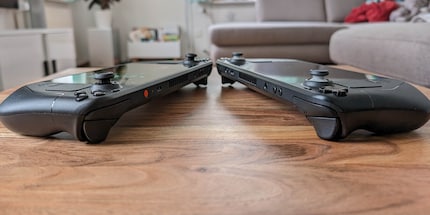
At 1,280 × 800 pixels, the OLED’s resolution is the same as its predecessor. This means the Steam Deck still has a lower resolution than every other comparable gaming handheld. The Wi-Fi 5 module has been ditched in favour of Wi-Fi 6E, with Bluetooth 5.3 replacing Bluetooth 5. As for the RAM, it now clocks at 6,400 MHz as opposed to 5,500 MHz. One change that’s even more crucial than this modest step forward is the chip’s manufacturing process. The AMD RDNA 2 CPU in the OLED is manufactured using the 6 nm process instead of the 7 nm used previously. Combined with the larger 50-watt-hour battery (previously a 40-watt-hour model) and the OLED display, this helps significantly extend the battery life.
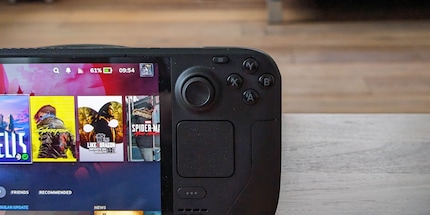
All Steam Decks have identical software. As I’ve mostly been using Windows handhelds like the Lenovo Legion GO over the past few months, I’m immediately struck by how much better the controls are on Valve’s handheld. It’s the only handheld console that you can simply switch on and start playing. No constant tinkering, updating drivers or struggling with the controls. Standby mode works reliably, while switching between games is uncomplicated. The Steam Deck is just much more fun than any of its rivals. Yes, it’s annoying that other launchers like Battle.net or Epic are a pain to install. And absolutely no Game Pass titles run on it locally. Even so, the user-friendliness of Valve’s SteamOS compared to Windows is still a huge advantage.
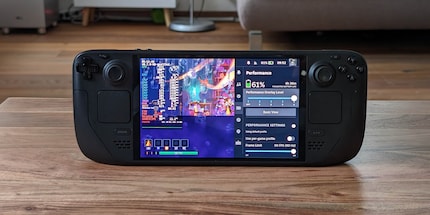
The best thing about the new Steam Deck is undoubtedly the OLED display. Like the Switch OLED before it, this gives games a visual update that doesn’t come at the expense of performance. The colours are bolder and more vibrant. Black really is black, making for much better contrasts. Not only that, but the OLED is much brighter than the LCD Steam Deck or the Switch OLED. As if that wasn’t enough, the Steam Deck OLED is also capable of HDR – something even its most expensive competitors can’t do. This provides an additional visual boost for games that support HDR.
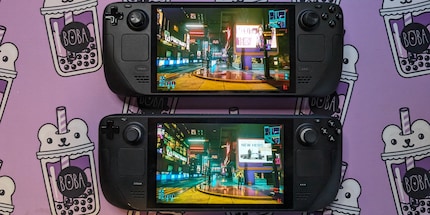
The Steam Deck OLED is almost like a new PC – I install old games on it first so that I can see how much better they perform. Titles like Hades, Cyberpunk 2077 Phantom Liberty and Stray look so much better. Experiencing the games in this renewed splendour is seriously fun. I can’t stress enough how much I prefer an OLED upgrade to a higher resolution or level of detail in a game.
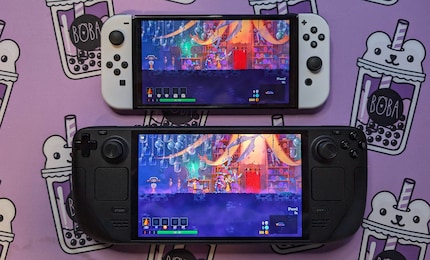
While we’re on the topic of the display, I should mention I tested the 512 GB version of the Steam Deck. Some reviewers have said the display on the 1 TB version doesn’t look as good. The culprit? Unlike the 512 version’s glossy screen, the 1 TB edition has an anti-glare coating. That being said, in some screen comparisons, you can hardly see any difference.
According to renowned tech YouTube channel Digitalfoundry, the input lag (time elapsed between pressing a button and its execution on the display) has drastically reduced. To be exact, by about 10 per cent when the display clocks at 60 Hz, and up to 30 per cent at 90 Hz. These are massive differences that create noticeable advantages in games requiring quick reactions. Personally, the input lag never bothered me on the original either.
Valve doesn’t advertise the Steam Deck OLED as a faster pro model. Despite this, various games run with 10-15 per cent more fps. During Cyberpunk 2077, I measured 34 fps without upscaling in the benchmark with the Steam Deck preset. That’s 4 fps more than the handheld’s predecessor. This is probably due to a combination of better cooling and the CPU being manufactured using the 6 nm process. Still, it basically offers about the same performance as its two-year-old predecessor.
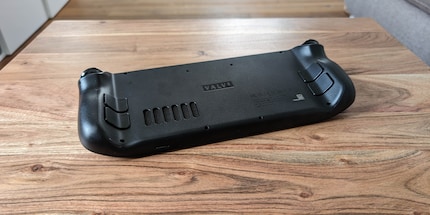
When the Steam Deck was launched, a lot of people criticised not only the fan, but the battery. As soon as a game required a little more power, you’d get one or two hours of playing time, and that was that. Thanks to the more energy-efficient HDR OLED display, more powerful battery and more efficient AMD chip, the new Steam Deck holds out far longer. To make a comparison, I kept a demanding scene in Cyberpunk 2077 running until each device switched off. With 90 Hz activated, the Steam Deck OLED lasted almost an hour longer (2 hours, 10 minutes) than the original Steam Deck at 60 Hz (1 hour, 15 minutes). A massive difference.
